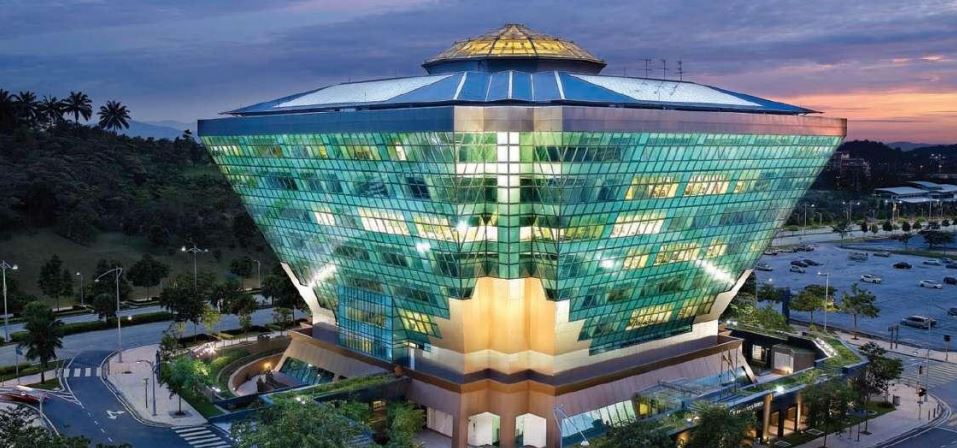Energy Commission
Corporate Office
Energy Commission Corporate Office in Precinct 2, Putrajaya
Client
Senandung Budiman Sdn. Bhd.
Cost
RM 80 Million
Location
Precinct 2, Putrajaya
Status
Completion June 2010.
The Diamond Building, located in Putrajaya, stands as the headquarters for the Malaysian Energy Commission (EC). It has recently been awarded the prestigious Asean Energy Awards in the category of new and existing buildings.
The Asean Energy Awards is a recognized competition within the region that grants international recognition to organizations implementing energy-efficient concepts, systems, and technology.
Another key aim of the winners is to serve as role models within the Asean area, encouraging the replication and promotion of energy-efficient management initiatives.
The architecture of the Diamond Building serves as a showcase for its commitment to decreasing energy usage and potable water consumption. It also actively promotes the use of sustainable building materials and strives to enhance the quality of indoor environments.
Of particular note, the Diamond Building holds the distinction of receiving a Platinum Certificate from both the Green Building Index (GBI) in Malaysia and Singapore’s Green Mark. These bodies perform similar roles to the Philippine Green Building Initiative (PGBI).
Unique Shape

The distinctive design of the Diamond Building was crafted in accordance with the climate and solar trajectory of equatorial Malaysia. Solar analyses indicated that the North and South exteriors would be naturally shaded due to 25-degree tilted facades, a design approach extended to the East and West facades as well. To optimize the utilization of natural light, a central atrium was incorporated into the design, resulting in the adoption of the diamond shape.
In terms of energy efficiency, the building boasts an Energy Efficiency Index (EEI) of 85 kWh/m2/year during its annual operation of 2,800 hours. This translates to a remarkable 65% reduction in energy consumption when compared to a typical office building in Malaysia, which typically has an average EEI of 210 kWh/m2/year.
Innovative Features
A standout feature of the building lies in its pioneering air-conditioning system, characterized by its unique attributes. This cutting-edge system incorporates both a floor-slab radiant-cooling mechanism and an air-convection system, synergistically contributing to the building’s innovative design.
-
Floor slab radiant cooling
The method of achieving radiant cooling via the floor slab involves chilling the reinforced concrete floor with water cooled to a temperature 18 to 20 degrees Celsius lower. This cooling process is facilitated by polyethylene-reinforced thermal pipes that are embedded within the concrete slab. These slabs function as thermal reservoirs, charged from 10 p.m. to 6 a.m. nightly, subsequently releasing cooling passively throughout the day.
The building’s design places significant emphasis on utilizing natural daylight, accounting for a minimum of 50 percent of the building’s illumination. Notably, this approach ensures that the interior space remains free from glare and experiences minimal heat influx.
Regarding lighting controls, three primary systems are employed: daylight sensors that automatically deactivate lighting when sufficient daylight is available; motion sensors for restrooms; and the implementation of multiple lighting circuits zoning throughout the building.
-
Passive Design
The inclusion of the tilted façade design yields a dual benefit: it not only results in a more compact building footprint but also paves the way for expanded landscaped areas encircling the structure. This astute design choice simultaneously curtails heat absorption within the building by fostering a verdant, cooler ambient environment around it. With each floor, ranging from the ground level to the seventh story, experiencing a 12 percent increase in space, the arrangement of offices and workstations along external walls and the central atrium is strategically optimized to harness abundant natural daylight.
An integrated triad of pivotal lighting control methods is harnessed, encompassing daylight sensors thoughtfully positioned in offices facing the façade and the atrium. These sensors operate in an autonomous fashion, effectively dimming or switching off lighting when ample natural illumination is present. The integration of motion sensors in restrooms and the meticulous implementation of diverse lighting circuits, intelligently demarcated throughout the building, deftly manage the multifaceted lighting requirements.
Furthermore, the building embraces the deployment of photovoltaic panels that harmoniously blend into the metal deck roof, offering both an aesthetic enhancement and a pragmatic functionality. This dual-purpose addition not only contributes to the visual appeal of the structure but also efficiently generates 10 percent of the building’s overall energy needs.



